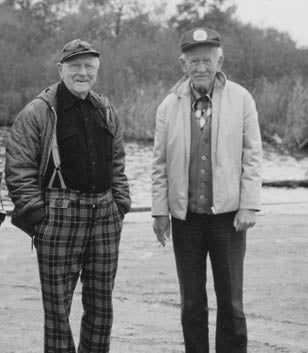I visited and talked to A. J. Casson (1898-1992) numerous times between 1985 and 1990 about the La Cloche area and the Group of Seven. The following article I wrote was printed in The Standard, Elliot Lake, Ontario on September 1, 1985.
Quotes from this article were used by Kevin Callan in his book ‘Killarney’ published by Boston Mills Press in 1990.
Photo – Joachim Gauthier and A. J. Casson in 1986 courtesy of Paul Gauthier.
Dream of A. J. Casson – revisiting La Cloche
“If I had my choice now, and at my age it’s not easy to get to these places, that’s the place I’d want to go again.”
That’s how Alfred Joseph Casson, 87 years old and the last surviving Group of Seven painter, remembers La Cloche.
Casson and his wife Margaret first visited the area in 1948 after seeing slides taken by a good friend Bruce Brown. As soon as he saw the images of the Picnic Islands and Baie Fine area he knew it was the place to be.
They first began going to the Birch Island Lodge, which at the time was run by the Corks, and then stayed at Widgawa Lodge, Whitefish Falls and on Manitoulin Island. Casson was last in the area four years ago when he stayed at Manitowaning and flew into the Casson Lake and Carmichael Lake area east of Willisville.
“I don’t think I ever got, anywhere, as much material as I did around La Cloche. You don’t have to hunt, you could get into one spot and work.”
Casson’s famous ‘White Pine’ was done near Dreamers Rock where he did numerous sketches looking out over the water and inland as well. ‘Fisherman’s Point’, which hangs in Kleinburg, was painted looking towards Baie Fine.
In 1926, Casson became a member of the Group of Seven. He was also the founding member of the Canadian Group of Painters, and co-founder of the Canadian Society of Painters in Watercolour, which is celebrating its 60th anniversary this year.
Of the Group of Seven, Casson, A. Y. Jackson, Franklin Carmichael, J. E. H. MacDonald and Arthur Lismer painted in the La Cloche area. After they broke ground many artists came to paint the quartzite hills and windswept pines.
Lismer did most of his painting at the end of McGregor Bay and would always leave from the Birch Island landing.
Carmichael and Jackson both did a lot of painting in the Grace Lake area where they spent time camping and sketching. Carmichael’s log cabin built in 1933-34 is on Cranberry Bay.
It was Casson who petitioned the government to have lakes named after Jackson and Carmichael and recently the same honour was given to Casson. Casson Lake is just north of the north west tip of Killarney Park while the other two are within the park boundaries.
While working as a commercial artist, before retiring in 1956, Casson traveled to many areas in Ontario on commission to do paintings.
In the early 50s he went to Kirkland Lake to do a painting for an annual report and returned once again to meet with the local art club.
“There was a man there who ran the local hardware store (R. A. Trussler) and his watercolours were good. I said to him that he should go into it full time and he said he’d been trying to sell his hardware store for years but he just couldn’t sell anything in that town.”
A few years ago Casson was offered a flight to Elliot Lake by a Toronto developer. He still hasn’t taken him up on it yet but is looking forward to seeing the area.
While camping on Lake Superior on a sketching trip Casson recalls looking across and seeing Marathon as a small community before the Hemlo rush.
Algonquin Park was a favourite spot, but now he’s found most of his spots covered with campsites and feels painters have to go 10 to 20 miles off the highway to be able to capture the beauty of the area.
Casson is dismayed at the areas of Ontario which have been ruined by the encroachment of man and industry. And he feels young artists today, instead of traveling the countryside, are spending too much time in the cities “imagining what it is like”.
“Looking back, the best things I’ve done were around the Madawaska Valley, Combermere, Bancroft and La Cloche. A lot of them are spoiled now.”
The out of doors have always been a favourite of Casson’s and a great amount of time has been spent traveling, camping and sketching the province of Ontario.
Carmichael who Casson began working with in 1919 as an assistant and who was a great friend and influence on his work, went on many fall camping and sketching trips with Casson.
“When Carmichael and I went camping, it was usually bad weather then in October, you can’t use watercolours then because there is too much damp and rain. We’d take our sketch box with the colour in it, another box with panels in it and a pencil pad and pencils and that’s about all. You had to travel light.”
Jackson traveled most of Canada and in the early years was always trying to get Casson to go to Quebec and paint.
‘The only place I think that Alec (A. Y. Jackson) didn’t cover was the Niagara Peninsula. He didn’t want the apple and peach blossoms. I think that is about the only part of Canada Alec wasn’t in.”
Now that Casson has recovered from his September ’84 heart surgery, he is once again looking forward to getting out in the field to sketch and paint. He is ready to finish a few paintings that he began before his illness.
“What I really need is a trip to get out and get some new material. I’ve got plenty but somehow I feel I need new. We haven’t been anywhere. I haven’t driven out of the city(Toronto) this summer.”

